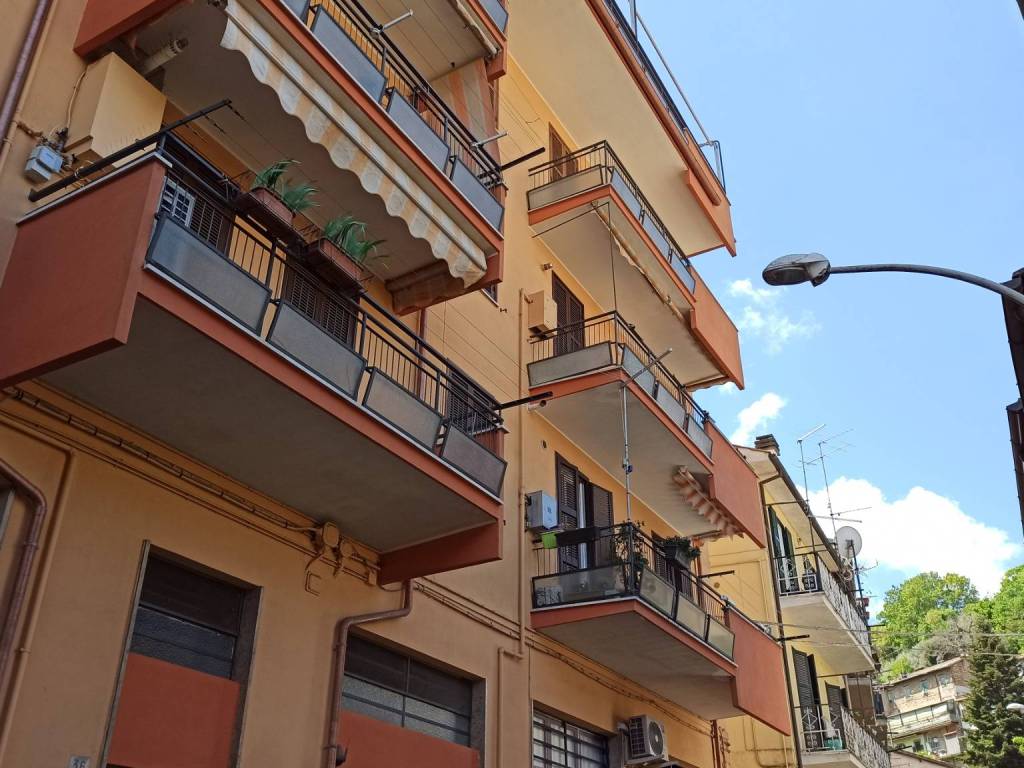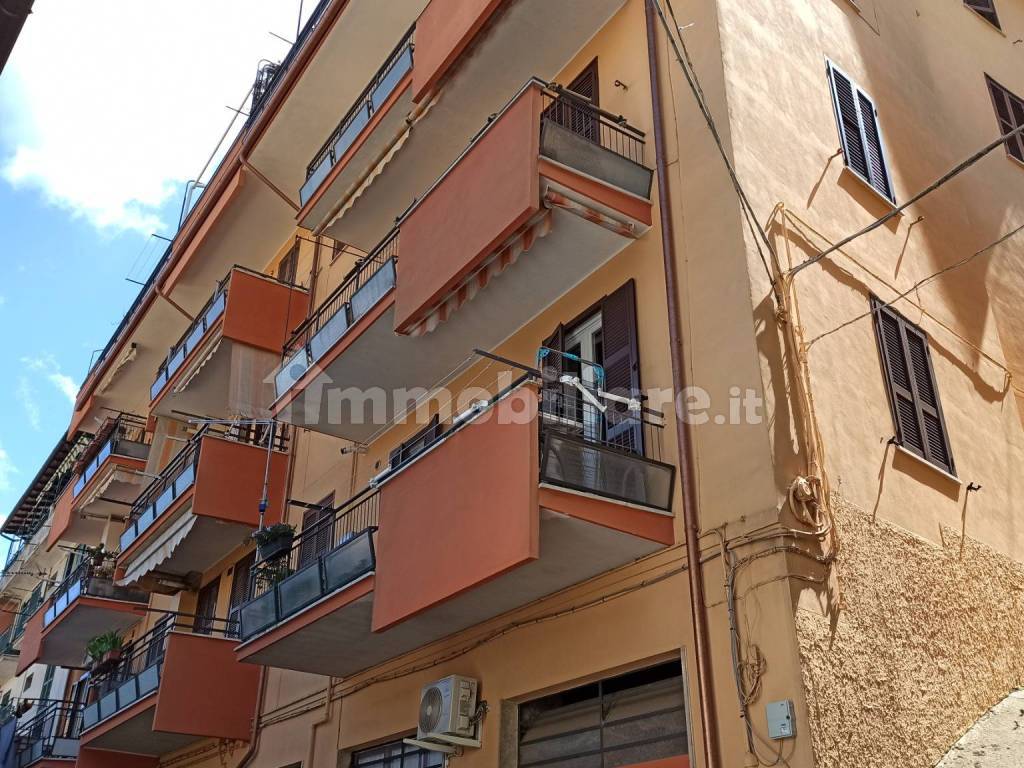
4-room flat viale dei Castagni, Centro, Soriano nel Cimino
Soriano nel CiminoViale dei Castagni- € 56,000
- 4
- 80m²
- 1
- 2
- No
Description
This description has been translated automatically by Google Translate and may not be accurate
Soriano nel Cimino, very close to the main square, very bright apartment comprising entrance hall, kitchen, lounge, closet, two large bedrooms, bathroom and balcony.
Roof and facade in excellent condition.
For more information 0761/1900314 soriano@ bonifazi.it
The first written testimony relating to the territory of Soriano comes from Tito Livio, who in his ab Urbe condita Historia, narrates that in 443 BC Soriano was invaded by the Roman militias commanded by the consul Quintus Fabio Massimo Rulliano; these, in the war against the Etruscans, managed to cross the impenetrable forest" that covered Mount Cimino and from the summit contemplated the expanse of fertile fields below populated and cultivated by the Etruscans, whom he routed with ease[7].
At the end of 3rd century AD the local populations were evangelized by Saint Eutizio of Ferento. After his martyrdom during the persecution by Diocletian, around 303 - 305 AD, the saint was buried in a catacomb near Soriano.
Between 6th and 8th centuries
Between the end of the 6th century and the beginning of the 8th, the Soriano territory was most likely the object of raids by the Lombards and the territory of Soriano was donated to the papacy by the Lombard king Liutprand, together with those of Sutri, Gallese, Blera, Bomarzo and Orte[7].
Between the 8th and 13th centuries
Between the 8th and 13th centuries, much of the Sorianese territory first belonged to the Benedictine monks of the Abbey of Sant'Andrea in flumine (near Monte Soratte) then to those of the monastery of S. Silvestro in Capite of Rome and finally to those of the convent of San Lorenzo outside the walls of Rome.
13th century
Throughout the Middle Ages in the Sorianese territory the number of rural villages, mainly of modest size and composed of a few houses gathered around small castles. But from the mid-13th century the village of Soriano began to take on considerable importance, built on a hill around the fortress-tower of the Guastapane and Pandolfo family, probably a branch of the Porcari family of Rome[10].
In 1250, the Guastapane family , siding with the Guelphs, welcomed Rosa da Viterbo to Soriano, a teenager exiled with her entire family from Viterbo by will of Frederick II, of the Ghibelline faction. In 1278 the Guastapane-Pandolfo family were accused of heresy and the barony of Soriano was taken away from them, entrusted to Orso Orsini, nephew of Pope Nicholas III. Since 1277, he had undertaken the construction of a castle around the tower-palace of the Guastapane-Pandolfo family; and Nicholas III himself lived in the fortress of Soriano in the summers of 1279 and 1280 and died here in the autumn of 1280.
The Orsini maintained the Soriano fiefdom until 1366, when, under the pontificate of Urban V, they sold it to the Saint See.
14th and 15th centuries
From 1379 to 1420 the fortress of Soriano was occupied by Breton mercenary troops, who descended into Italy to counter the populations rebelling against the Holy See but then became opponents of the Pope and in favor of the antipopes of Avignon, following of the Western Schism.
In 1431 Pope Eugene IV ascended the throne by will of the Orsini, hostile to the Colonnas; these rebelled against the papacy by allying themselves with Giacomo di Vico, lord of Vetralla and exponent of the powerful family of the Prefects of Vico. At the end of 1431 the village and the castle were handed over to Cardinal Giovanni Vitelleschi and the Colonnas agreed with the Pope by isolating Di Vico who was beheaded in the churchyard of the Collegiate Church of Soriano (the current Church of Sant'Eutizio).
In 1441 the Holy See regulates the administrative system of the community of Soriano: a Farmer or Camerlengo is placed in charge of income and assets, a Podestà or Governor is in charge of governing the town and a Castellan is in charge of managing the fortress.
Between 1447 and in 1455, under Pope Nicholas V, the town enjoyed a period of peace: the first municipal statute was drawn up, legal and pecuniary privileges were granted to the population and important urban planning works were started, including the restoration of the walls of the town and the construction of the old fountain to guarantee the population's water supply.
When Innocent VIII ascended the throne in 1484, Soriano was assigned a perpetual vicariate to Cardinal Rodrigo Borgia, the future Pope Alexander VI, who appointed the Spanish Didaco de Carvajal.
On 7 November 1489 one of the most important events in the history of the town took place, so much so that it is still recalled today during the Chestnut Festival: Carvajal was treacherously killed by Count Pietro Paolo Nardini, feudal lord of Vignanello, who attempted to take possession of Soriano together with four courtiers who were his accomplices. The population, however, manages to discover and capture Nardini, who is killed and falls from the highest tower of the castle, and to defeat and put to flight his soldiers who, warned by the signals made with a torch by the traitors from the top of the tower, were rushing to conquer the village but who were defeated in what went down in the city's history as the battle of the ditch of the good meeting.--6449c06084f38986cf59bf05ed349573!
Roof and facade in excellent condition.
For more information 0761/1900314 soriano@ bonifazi.it
The first written testimony relating to the territory of Soriano comes from Tito Livio, who in his ab Urbe condita Historia, narrates that in 443 BC Soriano was invaded by the Roman militias commanded by the consul Quintus Fabio Massimo Rulliano; these, in the war against the Etruscans, managed to cross the impenetrable forest" that covered Mount Cimino and from the summit contemplated the expanse of fertile fields below populated and cultivated by the Etruscans, whom he routed with ease[7].
At the end of 3rd century AD the local populations were evangelized by Saint Eutizio of Ferento. After his martyrdom during the persecution by Diocletian, around 303 - 305 AD, the saint was buried in a catacomb near Soriano.
Between 6th and 8th centuries
Between the end of the 6th century and the beginning of the 8th, the Soriano territory was most likely the object of raids by the Lombards and the territory of Soriano was donated to the papacy by the Lombard king Liutprand, together with those of Sutri, Gallese, Blera, Bomarzo and Orte[7].
Between the 8th and 13th centuries
Between the 8th and 13th centuries, much of the Sorianese territory first belonged to the Benedictine monks of the Abbey of Sant'Andrea in flumine (near Monte Soratte) then to those of the monastery of S. Silvestro in Capite of Rome and finally to those of the convent of San Lorenzo outside the walls of Rome.
13th century
Throughout the Middle Ages in the Sorianese territory the number of rural villages, mainly of modest size and composed of a few houses gathered around small castles. But from the mid-13th century the village of Soriano began to take on considerable importance, built on a hill around the fortress-tower of the Guastapane and Pandolfo family, probably a branch of the Porcari family of Rome[10].
In 1250, the Guastapane family , siding with the Guelphs, welcomed Rosa da Viterbo to Soriano, a teenager exiled with her entire family from Viterbo by will of Frederick II, of the Ghibelline faction. In 1278 the Guastapane-Pandolfo family were accused of heresy and the barony of Soriano was taken away from them, entrusted to Orso Orsini, nephew of Pope Nicholas III. Since 1277, he had undertaken the construction of a castle around the tower-palace of the Guastapane-Pandolfo family; and Nicholas III himself lived in the fortress of Soriano in the summers of 1279 and 1280 and died here in the autumn of 1280.
The Orsini maintained the Soriano fiefdom until 1366, when, under the pontificate of Urban V, they sold it to the Saint See.
14th and 15th centuries
From 1379 to 1420 the fortress of Soriano was occupied by Breton mercenary troops, who descended into Italy to counter the populations rebelling against the Holy See but then became opponents of the Pope and in favor of the antipopes of Avignon, following of the Western Schism.
In 1431 Pope Eugene IV ascended the throne by will of the Orsini, hostile to the Colonnas; these rebelled against the papacy by allying themselves with Giacomo di Vico, lord of Vetralla and exponent of the powerful family of the Prefects of Vico. At the end of 1431 the village and the castle were handed over to Cardinal Giovanni Vitelleschi and the Colonnas agreed with the Pope by isolating Di Vico who was beheaded in the churchyard of the Collegiate Church of Soriano (the current Church of Sant'Eutizio).
In 1441 the Holy See regulates the administrative system of the community of Soriano: a Farmer or Camerlengo is placed in charge of income and assets, a Podestà or Governor is in charge of governing the town and a Castellan is in charge of managing the fortress.
Between 1447 and in 1455, under Pope Nicholas V, the town enjoyed a period of peace: the first municipal statute was drawn up, legal and pecuniary privileges were granted to the population and important urban planning works were started, including the restoration of the walls of the town and the construction of the old fountain to guarantee the population's water supply.
When Innocent VIII ascended the throne in 1484, Soriano was assigned a perpetual vicariate to Cardinal Rodrigo Borgia, the future Pope Alexander VI, who appointed the Spanish Didaco de Carvajal.
On 7 November 1489 one of the most important events in the history of the town took place, so much so that it is still recalled today during the Chestnut Festival: Carvajal was treacherously killed by Count Pietro Paolo Nardini, feudal lord of Vignanello, who attempted to take possession of Soriano together with four courtiers who were his accomplices. The population, however, manages to discover and capture Nardini, who is killed and falls from the highest tower of the castle, and to defeat and put to flight his soldiers who, warned by the signals made with a torch by the traitors from the top of the tower, were rushing to conquer the village but who were defeated in what went down in the city's history as the battle of the ditch of the good meeting.--6449c06084f38986cf59bf05ed349573!
Information
- other features
- Optic fiberExternal exposureBalconySingle tv systemWindow frames in glass / PVC
Features
- Reference and listing Date
- 81270 - 04/19/2024
- contract
- Sale
- type
- Apartment | Full ownership | Medium property class
- surface
- 80 m² - See detail
- rooms
- 4 (2 bedrooms, 2 others), 1 bathroom, kitchen diner
- floor
- 2°
- total building floors
- 4 floors
- Car parking
- 1 in shared parking
- availability
- Available
- other features
- Optic fiberExternal exposureBalconySingle tv systemWindow frames in glass / PVC
Expenses
- price
- € 56,000
- condominium fees
- € 40/month
Energy efficiency
- year of construction
- 1960
- condition
- Good condition / Liveable
- heating
- Independent, with radiators, powered by methane
- Energy Efficiency
- G≥ 175 kWh/m² year
Floorplan

Discover the best electricity and gas offers

E-Light Luce
Enel Energia's fixed-price electricity offer is more convenient for you

E-Light Gas
Enel Energia's fixed-price gas offer is more convenient for you
Additional options





























